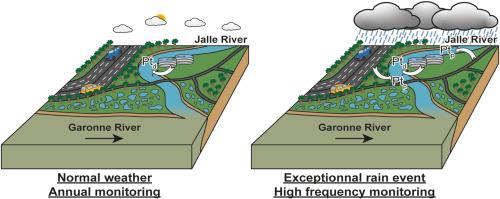Highway runoff and wastewater effluents as drivers of platinum dynamics in an urban river: Insights from a comprehensive monitoring study
IF 3.4
3区 地球科学
Q1 GEOCHEMISTRY & GEOPHYSICS
引用次数: 0
Abstract
The contribution of a single rain event to daily and annual platinum (Pt) transport in an urban river (Jalle River, South-West of France), assessed from high resolution and annual monitoring, is discussed in terms of dissolved (Ptd) and particulate (Ptp) partitioning, sources and fluxes. In normal discharge conditions, the Jalle River Ptd and Ptp concentrations are respectively 1.90 ± 1.62 ng L−1 and 19.8 ± 6.9 μg kg−1 and Pt is mostly transported in the dissolved form (∼96 %, 110 ± 123 mgPtd d−1), due to low sediment yield and urban discharges from a wastewater treatment plant (WWTP). The Ptd flux in sewage (36–340 mgPtd d−1) was mainly attributed to excretions from patient undergoing chemotherapy with Pt-drugs (up to 480,000 mgPtd yr−1 at the watershed scale). After a 2-months dry period, an intense rainstorm discharged ≥112 mg of Ptp in 4 h from the urban highway, resulting in additional 295 mgPtp d−1 exceptionally transported by the Jalle River. In contrast to normal conditions, during the rainstorm up to ∼95 % of Pt was transported in particulate form during the first flush, and 80 % of the highway Ptp flux during the first 40 min contributing to ∼one third of the annual Ptp flux. Short, intense discharge events must be monitored at a high resolution to accurately estimate annual Pt fluxes in urban rivers.

公路径流和废水排放是城市河流中铂动态的驱动因素:来自全面监测研究的见解
通过高分辨率和年度监测评估了一次降雨事件对城市河流(法国西南部的贾勒河)每日和年度铂(Pt)运输的贡献,并从溶解(Ptd)和颗粒(Ptp)分配、来源和通量的角度进行了讨论。在正常排放条件下,贾勒河的Ptd和Ptp浓度分别为1.90±1.62 ng L - 1和19.8±6.9 μg kg - 1,由于产沙量低和污水处理厂(WWTP)的城市排放,Pt主要以溶解形式运输(约96%,110±123 mgPtd d - 1)。污水中的Ptd通量(36-340 mgPtd d - 1)主要归因于接受pt药物化疗的患者的排泄物(在流域尺度上高达48万mgPtd yr - 1)。在2个月的干旱期后,一次强暴雨在4 h内从城市高速公路排出了≥112 mg的Ptp,导致贾勒河额外输送了295 mgPtp d−1。与正常情况相比,在暴雨期间,高达95%的Pt在第一次冲水时以颗粒形式输送,在前40分钟内80%的公路Ptp通量贡献了年Ptp通量的约三分之一。为了准确估计城市河流中每年的铂通量,必须对短时间、高强度的排放事件进行高分辨率监测。
本文章由计算机程序翻译,如有差异,请以英文原文为准。
求助全文
约1分钟内获得全文
求助全文
来源期刊

Applied Geochemistry
地学-地球化学与地球物理
CiteScore
6.10
自引率
8.80%
发文量
272
审稿时长
65 days
期刊介绍:
Applied Geochemistry is an international journal devoted to publication of original research papers, rapid research communications and selected review papers in geochemistry and urban geochemistry which have some practical application to an aspect of human endeavour, such as the preservation of the environment, health, waste disposal and the search for resources. Papers on applications of inorganic, organic and isotope geochemistry and geochemical processes are therefore welcome provided they meet the main criterion. Spatial and temporal monitoring case studies are only of interest to our international readership if they present new ideas of broad application.
Topics covered include: (1) Environmental geochemistry (including natural and anthropogenic aspects, and protection and remediation strategies); (2) Hydrogeochemistry (surface and groundwater); (3) Medical (urban) geochemistry; (4) The search for energy resources (in particular unconventional oil and gas or emerging metal resources); (5) Energy exploitation (in particular geothermal energy and CCS); (6) Upgrading of energy and mineral resources where there is a direct geochemical application; and (7) Waste disposal, including nuclear waste disposal.
 求助内容:
求助内容: 应助结果提醒方式:
应助结果提醒方式:


